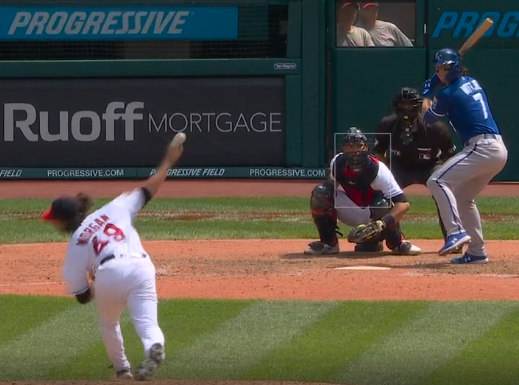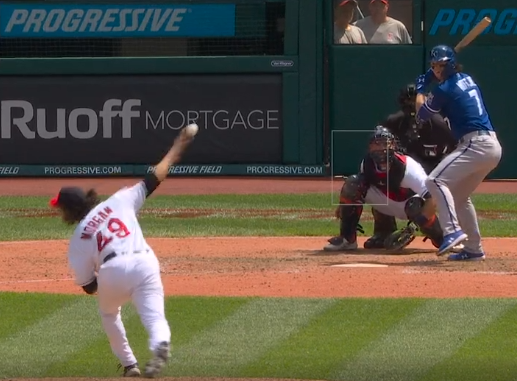Eli Morgan Is Cleveland’s Latest Pitching Revelation

Eli Morgan is one of the best-kept secrets in baseball. He’s not a high-leverage reliever for a marquee team. He’s not even the best or most famous reliever on his own team. Heck, he was a middling five-and-dive starter in the majors just last year. But none of that matters anymore, because now he has a cheat code:
That changeup is absolutely ludicrous. It looks like no other pitch in baseball. It’s slow, much slower than the rest of Morgan’s arsenal. Every other one of his pitches is in the vicinity of league average, while his changeup is the slowest in baseball. That makes for huge separation from his fastball; if the two started on the same trajectory, the changeup would fall 30 more inches than the fastball on its way to home plate. That’s nearly half an Altuve.
You can see the power of the pitch in this arbitrarily chosen Morgan appearance. His fastball has two-plane movement but generally looks like the back-spinning four-seamers that are so popular these days; Bobby Witt Jr. tracks it for an uneventful ball one:
With two strikes, Witt surely would have swung at that fastball; it’s too close to take. And so, after reaching two strikes, Morgan attacks the same region, only with a changeup:
That’s a near-perfect pitch. You can’t take it; it’s squarely in the strike zone. You want to swing at it? Unless you’re sitting changeup, your swing is going to be all out of whack; it’s a 75 mph pitch from a guy who sits 91-92. And while it’s hard to judge pitcher deception from a center field camera, Morgan seems to have it. His herky-jerky release and fall-to-the-side delivery is already hard enough to figure out, and he matches release and arm action well. Here’s one of his two pitches to Witt, snapped at release:

Here’s the other pitch:

It’s hard to tell the two apart (for what it’s worth, the first one was the fastball) from behind, and I doubt it’s any easier at game speed, particularly when you haven’t seen Morgan yet. He has an abnormally high release point for someone of his short stature – he’s listed at 5-foot-10 – and hitters have to find that release point quickly, because he keeps his arm hidden until deep in the delivery.
All that might be overkill, though. It’s hard to hit his changeup because there are no other pitches like it. Hitters see plenty of 75 mph pitches, but they’re almost exclusively curveballs. They see 75 mph pitches in batting practice, too, but they’re two-plane fastballs. A 75 mph pitch coming from a high arm slot and tailing strongly sideways? There’s just not much to compare it to.
If you’re feeling expansive, the best match for Morgan’s changeup might be Mike Morin. Morin sat in the low-90s with his fastball and used a mid-70s changeup roughly a third of the time during his career (he hasn’t officially retired, but he also hasn’t played affiliated ball in two years). You might not remember Morin’s changeup, but hitters who faced him probably do: it was his best pitch by a mile, and single-handedly kept him in the majors for years.
Still, even then, the comparison is only so-so. Morin’s changeup was more or less a straight change; not much horizontal break to speak of, and slight backspin, which meant it fell less on its flight home than you might expect. Morgan’s has strong arm-side run; it breaks nearly a foot to his arm-side on its path home, with nearly no backspin to speak of. You can think of it as an exaggerated sinker; it falls and fades, only for much longer than you’d expect thanks to its slow speed.
In practical terms, that means that batters can’t do anything with it even if they manage to get a bat on it. The pitch’s 11.1% swinging strike rate doesn’t jump out, nor does its 15.4% called strike rate. That 26.5 CSW% (called and swinging strikes combined) is only a hair higher than the league’s mark of 24.3% on changeups. But it’s still one of the most effective changeups in the game, even as Morgan uses it nearly a third of the time, because merely making contact with it doesn’t guarantee success.
Batters have put 25 of Morgan’s changeups into play so far this year. They’ve hit only six of them 95 mph or harder, a 24% clip. They’ve popped up three of those 25, which is remarkable for a pitch that falls so much on its flight home. Overall, batters are hitting .120 with a .200 slugging percentage when they manage to put Morgan’s changeup into play, good for a .137 wOBA. Their expected numbers aren’t much better; per Statcast, only five pitchers have lower xwOBAs against their changeups on balls in play.
Could some of that be a sample size issue? Most definitely. Twenty-five changeups just isn’t that many, and Morgan’s changeup was less effective last year. He surrendered six home runs on the pitch in 2021, and let me tell you, allowing a home run on a slow changeup makes you look very silly on a highlight reel:
In my mind, using Morgan as a reliever mitigates the home run risk significantly. It’s a lot easier to stay back on a pitch when you’ve already seen it three or four times, and Morgan does use his changeup quite a bit, so overexposure is a real risk. When he’s coming in for a single time through the order, though, and liberally mixing it with his lively fastball, there’s not much time to get comfortable.
Does that make Morgan a lifelong reliever? I’m in that camp for now, though I’m sure Morgan would love to prove me wrong. The biggest thing preventing him from being a starter, at least in my opinion? He doesn’t have a plus breaking ball, which means he needs to rely heavily on his changeup as a secondary pitch. That’s fine – again, it’s a unicorn pitch that batters have been helpless against – but using a slow and not particularly bendy pitch in the strike zone multiple times through an order is a risky proposition.
Morgan’s slider is held back by his delivery, as he explained to David Laurila last year. His natural pronation helps his changeup dip and fade, but it makes supinating to throw a slider more difficult. Accordingly, he’s thrown the pitch less often this year, only 13% of the time, choosing to feature his fastball and changeup instead.
But there’s hope for that slider. Unlike his changeup, it has plenty of lookalike pitches in the majors, and some of them are quite good. Call it a Cleveland specialty; per Alex Chamberlain’s pitch comparison tool, Morgan’s slider looks like the hard breaking balls thrown by Zach Plesac, Shane Bieber, and former Cleveland hurler Josh Tomlin, fine company for a pitch that is admittedly his third-best. It’s hardly a sweeper – it’s more a cutter than anything else, despite its classification as a slider – but a third viable pitch would change my opinion of Morgan significantly. (For the record, the pitch comparison tool thinks that Morgan’s changeup has no lookalikes.)
To match the slider success of those other pitchers, Morgan will have to improve his breaking ball command. Bieber, Tomlin, and Plesac live on the glove-side edge with their hard breaking balls. For Morgan, that’s still a work in progress. That’s not a problem given the way he uses it now – almost always as a surprise, either to steal a strike when down in the count or to bait righties into a bad swing with two strikes – but boost the usage rating up to 25 or 30%, and the number of “surprise” sliders you can get away with will naturally drift down.
Honestly, though, that’s a good problem to have. If I told you two years ago that Eli Morgan was going to either be an impact reliever (with no further improvements) or a mid-rotation starter (if he improves his slider), you might have scoffed. He missed his fair share of bats in the minors, but c’mon: a short guy who doesn’t throw hard and doesn’t have a breaking ball? It beggared belief.
That’s pretty clearly not the case anymore. He’s missing as many bats as he ever did in the minors. His fastball command has taken a step forward, and he’s hardly walking anyone now. Will he keep allowing a microscopic .155 BABIP and sustain a 1.82 ERA? Obviously not, but his ERA estimators are none too shabby either. Don’t call him a closer – Cleveland has one of those – and don’t call him a starter just yet, but do call him one of the best pitchers on the Guardians, and an underrated driver of their push towards AL Central supremacy.
Ben is a writer at FanGraphs. He can be found on Bluesky @benclemens.

The pitching factory scores again!
Pilkington has done okay. Better than AAA. And he’s a lefty.
Yet to come:
Daniel Espino.
Gavin Williams
Joey Cantillo.
Xzavion Curry.
Tanner Burns.
It’s an assembly line at Akron.
(Check their stats.)
Doubt they’ll finish the season there.
Given the rate at which prospects fail, only two are likely to get to Cleveland and succeed but the ones that make it should keep the pipeline full.